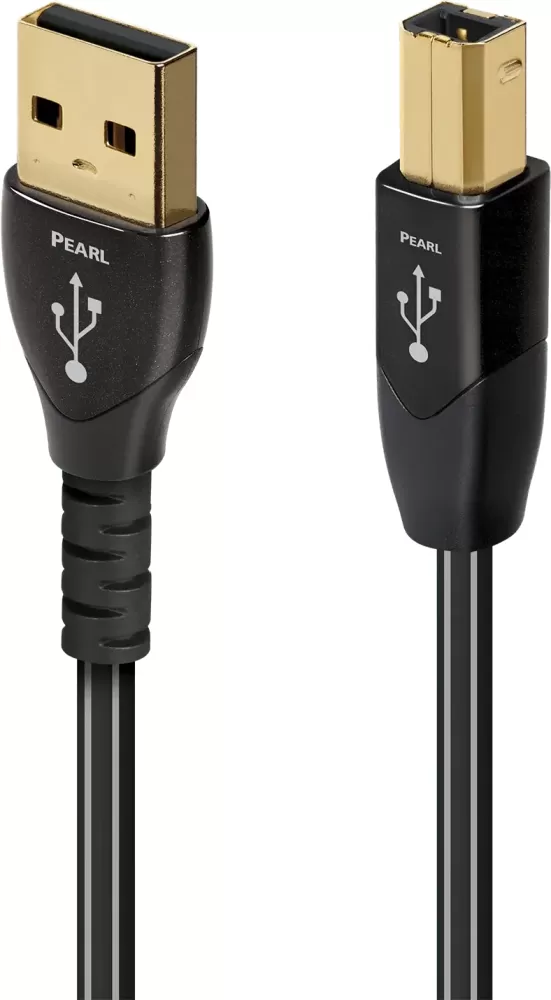The AudioQuest Pearl USB-A to USB-B cable is engineered to provide a superior connection between your devices, featuring high-purity Long-Grain Copper (LGC) conductors. LGC is known for its ability to preserve signal integrity by minimizing the grain boundaries that can disrupt signal flow, allowing for cleaner and more accurate data transmission.
In addition to its high-quality conductors, the Pearl USB cable incorporates a Metal-Layer Noise-Dissipation system that effectively reduces radio-frequency noise. This system ensures that external interference is minimized, allowing the signal to pass through with less distortion. As a result, the Pearl USB cable delivers enhanced audio and data performance, offering a clearer, more reliable connection between your devices.
Solid Long-Grain Copper (LGC) Conductors
The AudioQuest Pearl USB cable features Solid Long-Grain Copper (LGC) conductors, which deliver a smoother, clearer signal compared to cables using standard Oxygen-Free High-Conductivity (OFHC) copper. Solid conductors eliminate strand interaction, which is a common source of distortion in multi-strand cables. The quality of the conductor's surface is essential, as it serves as a guide for both electric fields within the conductor and magnetic fields outside of it. LGC’s superior purity, with fewer oxides and impurities, along with a reduction in grain boundaries, leads to a more efficient and accurate signal transmission, resulting in enhanced overall performance.
Metal-Layer Noise-Dissipation
While many cables achieve 100% shield coverage, the real challenge is preventing captured radio-frequency interference (RFI) from distorting the equipment's ground reference. AudioQuest's Metal-Layer Noise-Dissipation system is designed to address this issue effectively. Traditional shielding systems simply absorb and drain noise or RF energy to the component ground, which can distort the critical ground plane and negatively impact the signal. In contrast, AudioQuest’s Noise-Dissipation technology "shields the shield," by absorbing and reflecting most of the noise and RF energy before it reaches the ground layer. This helps preserve the integrity of the signal, ensuring a cleaner, more accurate audio transmission.
Hard-Cell Foam Insulation
Hard-Cell Foam (HCF) Insulation is used in the AudioQuest Pearl USB cable to ensure precise signal-pair geometry, which is essential for maintaining the integrity of the signal. Any solid material near a conductor can introduce imperfections in the circuit, as insulation and other materials tend to absorb energy, which is then released as distortion. Unlike traditional insulating materials, Hard-Cell Foam is nitrogen-injected, creating air pockets within the foam. Since nitrogen (like air) does not absorb energy, it eliminates the risk of releasing energy back into the conductor, reducing distortion. Additionally, the rigidity of the foam ensures that the cable’s conductors remain in a stable alignment along the cable’s length, helping to maintain consistent impedance and further minimizing signal degradation.
Direction-Controlled Conductors
Every metal conductor has a non-symmetrical, directional grain structure that can impact signal integrity if not properly controlled. AudioQuest carefully manages this grain structure to optimize the flow of the signal and minimize the potential for noise interference. By controlling the RF impedance variations, AudioQuest ensures that any induced noise is drained away from areas where it could distort the audio signal. The correct direction for the conductors is determined through careful listening tests with every batch of metal used in their cables. Arrows are marked on the connectors of most AudioQuest cables to indicate the optimal direction for signal flow. These arrows not only help with metal-directionality as part of the Noise-Dissipation system, but also align the shield and ground connections to enhance overall system performance. This approach is a key component of AudioQuest’s advanced Noise-Dissipation technology, ensuring the audio signal remains clean and undistorted throughout transmission.
|
|





Validate your login
Sign In
Create New Account